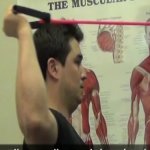There may be a connection between external rotation strength and shoulder injury.
A new study examined 58 elite level tennis players. 20 of these athletes had a history of shoulder injury, while 38 did not. Serve velocity, joint mobility, and strength were all assessed in order to compare differences between groups.
Isometric external rotation strength, as well as ER:IR strength ratio, was significantly lower in the subjects with a history of shoulder pain.
Conclusions
It is impossible to know for certain whether the weak external rotation was a contributor to the injuries or whether it occurred as a symptom of the injuries. Additional trials that test the value of ER strengthening would be valuable. Nonetheless, I think there is value in incorporating exercises in which the humerus rotates inside the glenoid, such as sidelying external rotations or face pulls, in populations susceptible to shoulder injury. Additionally, exercises such as arm bars or DNS rolling patterns, in which the glenoid rotates over a fixed humerus, may also be valuable.
References
